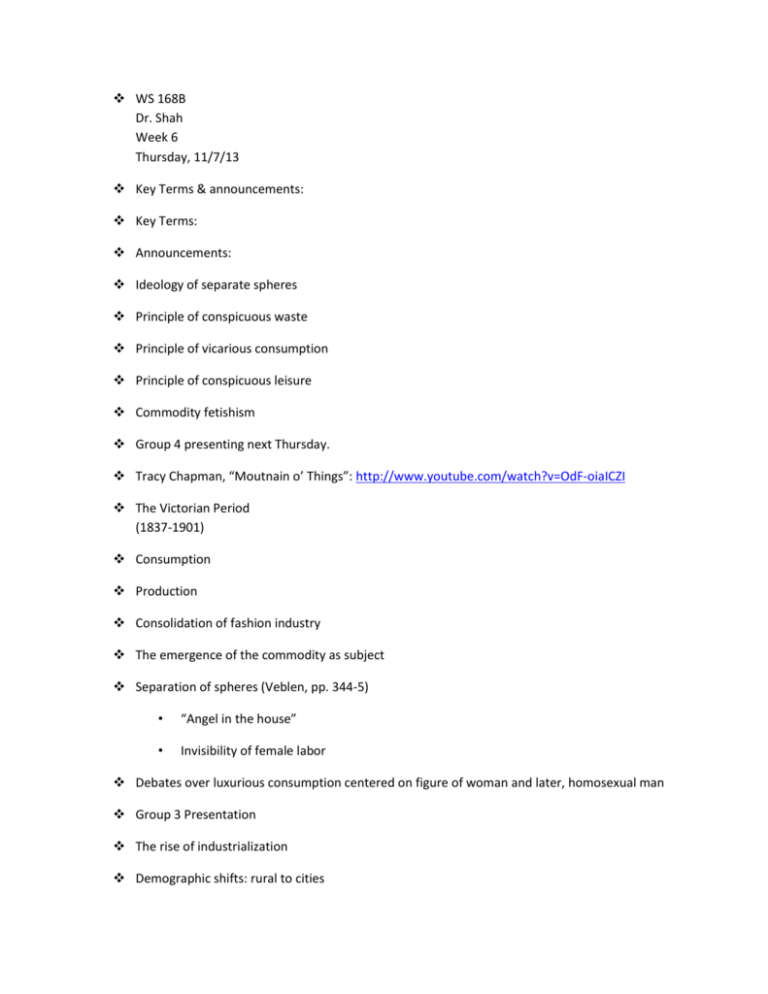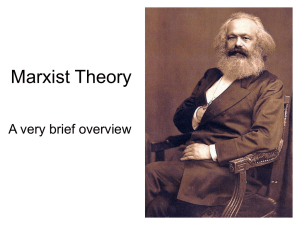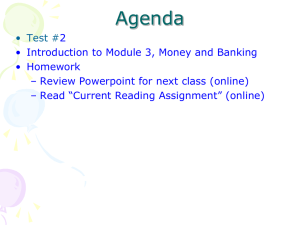
WS 168B
Dr. Shah
Week 6
Thursday, 11/7/13
Key Terms & announcements:
Key Terms:
Announcements:
Ideology of separate spheres
Principle of conspicuous waste
Principle of vicarious consumption
Principle of conspicuous leisure
Commodity fetishism
Group 4 presenting next Thursday.
Tracy Chapman, “Moutnain o’ Things”: http://www.youtube.com/watch?v=OdF-oiaICZI
The Victorian Period
(1837-1901)
Consumption
Production
Consolidation of fashion industry
The emergence of the commodity as subject
Separation of spheres (Veblen, pp. 344-5)
•
“Angel in the house”
•
Invisibility of female labor
Debates over luxurious consumption centered on figure of woman and later, homosexual man
Group 3 Presentation
The rise of industrialization
Demographic shifts: rural to cities
Shifts in labor relations, mechanization
Shift toward home production (destruction of Indian indigenous textile industries)
Raw materials and tax revenues coming from colonies
Manchester Cotton: The Victorian Era and Industrialization:
http://www.youtube.com/watch?v=MllrnSZxTkY
“dress as an expression of the Pecuniary culture”
Thornstein Veblen (339)
“Consumption as communication thesis” – fashion most radical expression
•
Veblen’s principles of consumption demonstrate a shift in thinking about what constitutes
civilization, taste, and beauty:
•
Commodity cultures has thoroughly transformed attitudes:
•
Principle of conspicuous waste (340-2)
•
Perceptions of modernity (342-3)
•
Read pp. 342-344 (old motives no longer make sense)
•
Read pp. 344-346 (women’s fashionable dress confirms the economic status of
women)
“the fetishism of the commodity and its secret”
Karl marx (345)
1760: French philosopher, Charles de Brosses, coined term “fetishism” to speak of “primitive
religion” (McClintock, 181)
•
Comte: stage prior to polytheism and then monotheism
•
fetishism is the attribution of inherent value or powers to an object
Fetishism
1867: Marx uses term commodity fetishism to express the obfuscation of labor and social
relations – objects’ value is determined in their relation to one another (value as a social
hieroglyphic)
1905: Freud uses the term to express the displacement of sexual desire onto alternative objects
or body parts (eg. a foot fetish or a shoe fetish), caused by the subject's confrontation with the
castration complex
(http://www.cla.purdue.edu/academic/engl/theory/psychoanalysis/freud4.html )
Reading Marx:
With a partner, find passages and/or quotations that can help us understand the following
concepts:
•
Commodity
•
Fetishism
•
Labor
•
Value
•
From where does the mystical character of the commodity arise?
•
How do we measure social relations in a commodity culture?
Anne McClintock’s definition of fetishism (185)
Social contradiction experienced at an intensely personal level
The displacement of the contradiction onto an object or person, which becomes the
embodiment of the crisis in value
The investment of intense passion (erotic or otherwise) in the fetish object
The repetitious, often ritualistic recurrence of the fetish object in the scene of personal or
historical memory
Kim Wood, “On My Knees”: http://www.kimwood.org/onmyknees/












